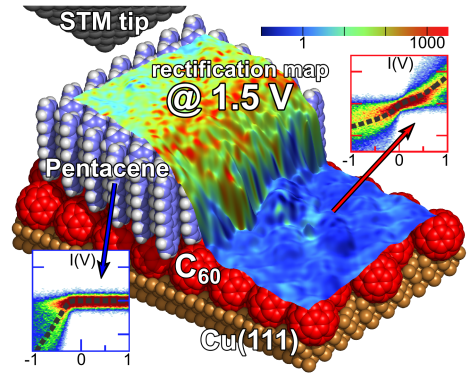
Article on US Department of Energy website.
Dr Joe Smerdon, UCLan, led a team of researchers including some from Argonne National Laboratory, Illinois, to construct a high-performance organic rectifier, or diode.
Molecular electronics is a focus for researchers worldwide, as it offers several benefits over bulk semiconductor electronics. It provides a potential solution to the fast-approaching fundamental atomic limitation to Moore’s law. This is the law, proposed by Gordon Moore of Intel, that computer performance doubles every 18 months. It is directly linked to the size of the transistors in microchips, the latest of which has a minimum feature size of 7 nm. This is just 28 atoms across. There is not much more room at the bottom!
Molecules offer a potential route around this limitation by permitting the construction of entire devices that use the intrinsic electronic structure of molecules to operate, rather than relying on doped semiconductors.
The fundamental building block of digital electronics is the diode.
Molecules also offer a solution to the energy crisis. The Sun bathes the Earth in enough energy in one hour to meet the global annual energy budget. Current photovoltaics are either low-efficiency or prohibitively expensive and include scarce and toxic elements. Organic photovoltaics are, so far, low efficiency – but they are cheap, compatible with roll-to-roll processing, printing, non-toxic, transparent and flexible. Who cares if they are only 5% efficient, when it’s possible to coat every surface with them, for pennies?
The fundamental device at the heart of every solar cell is a diode.
Pentacene is a molecule that wants to be a diode: it has the perfect electronic structure, which has already led to its inclusion in prototype devices. However, its electronic identity is lost when it contacts a metal, which it needs to do to be connected to conventional electronics. Joe Smerdon and coworkers have discovered that, by using a buffer layer of buckyballs, a so-called Schottky rectifier can be constructed from pentacene. Using an atomic resolution scanning tunnelling microscope, they demonstrate not only that this device rectifies, it rectifies, as far as the microscope is capable of detecting, perfectly. Currently used (bulk) diodes need a rectification ratio (the ratio of forward current to backward current for a given voltage bias) of around a million. The new device achieves 1000, far in excess of any other device on its scale, and the limit of measurement of the technique used. Using an additional, less reliable, technique, the measurement jumps to 100,000 (again, instrument limited).
This discovery paves the way to the inclusion of buckyball-based Schottky interfaces in all organic devices that benefit from rectification. The obvious application is solar cells, since we are not yet near to the first organic computer (well, the first artificial organic computer, at least).
Article in Nano Letters.
